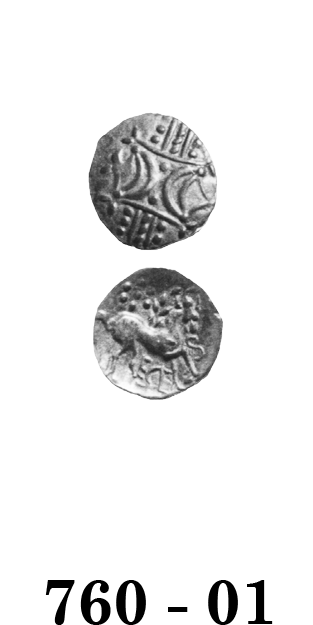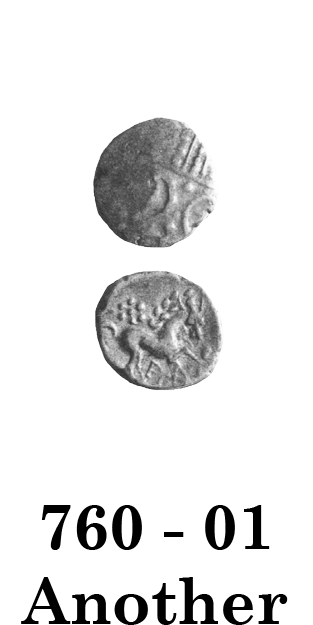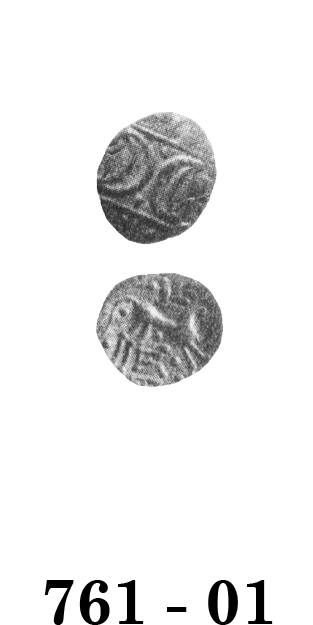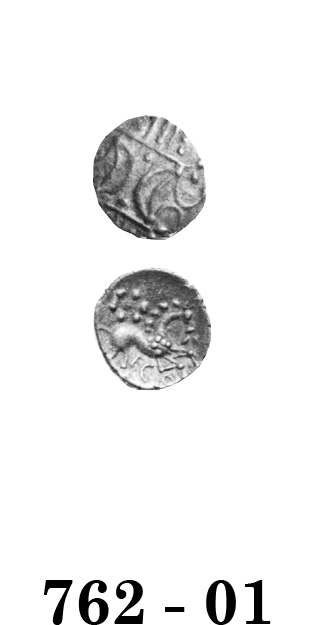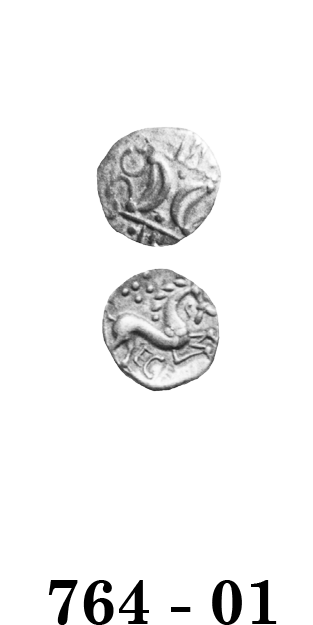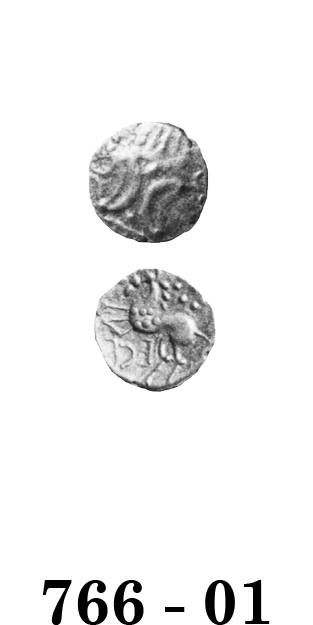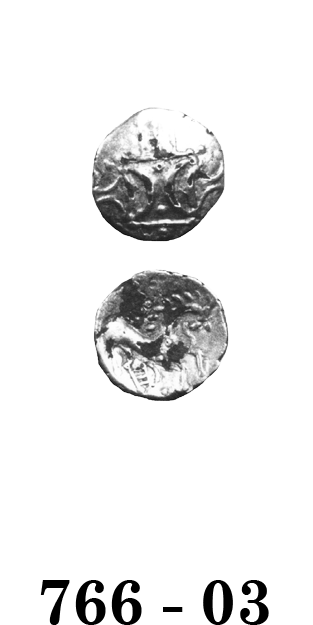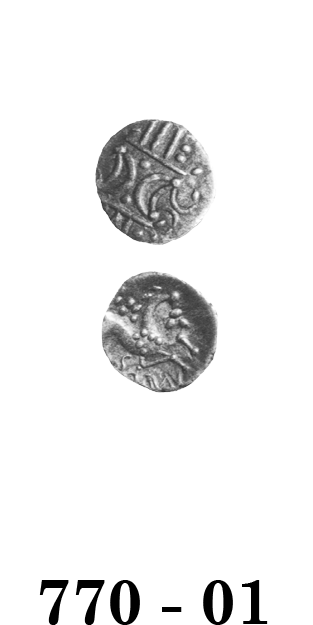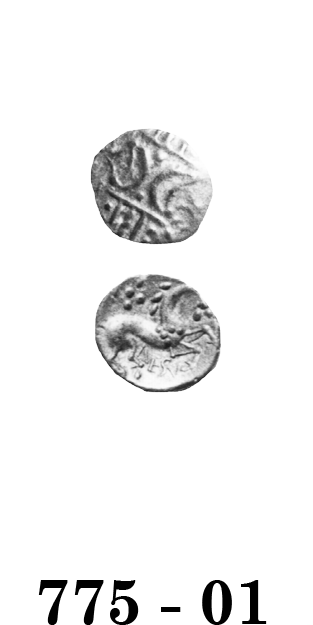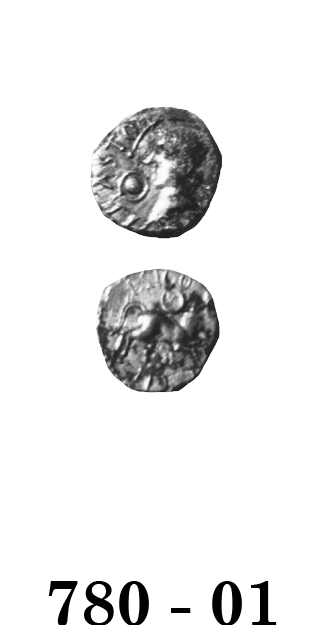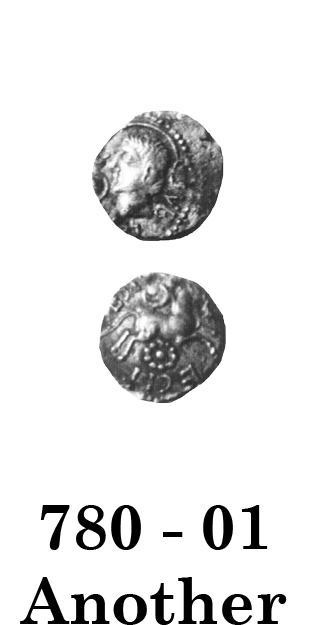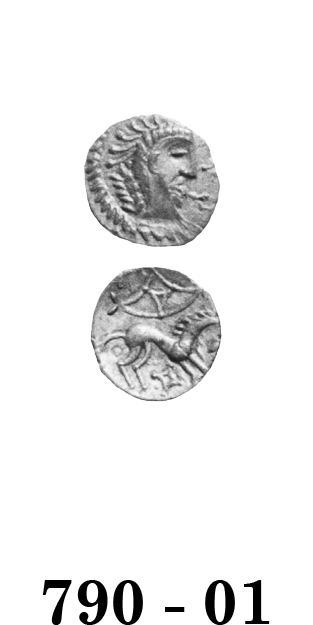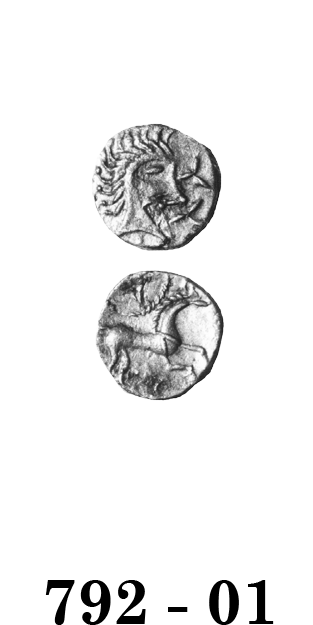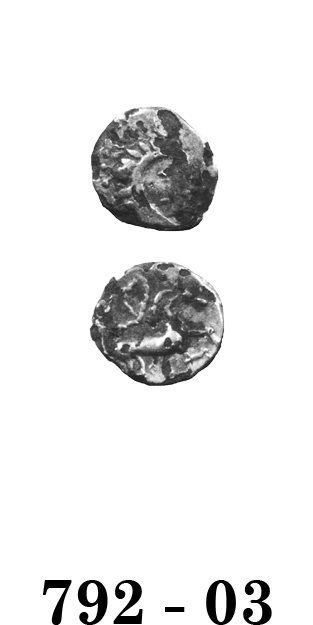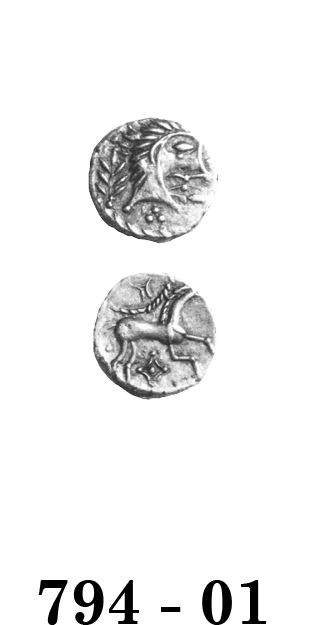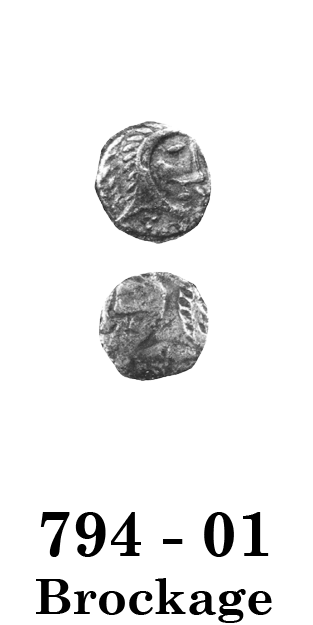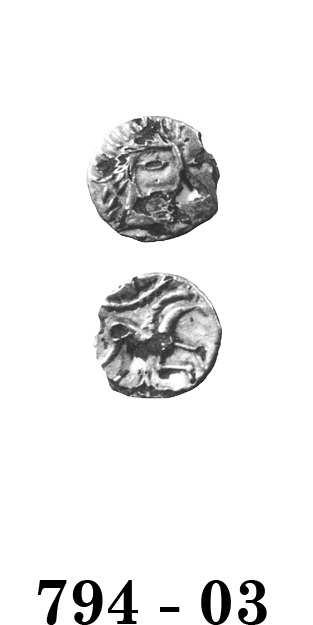
Celtic Coinage of Britain
third edition
Click on coin to see hidden information
Icenian Dynastic Coinages
At the end of the uninscribed coinages, an enigmatic coin appeared with the inscription CANI DURO. This may have been a local issue, or alternatively, the start of the dynastic issues.
The first certain dynastic issues start with the inscription ANTED, about 20 A.D. It is difficult to explain why the Iceni failed to inscribe their coins prior to this, possibly the Trinovantes/Catuvellauni exercised some influence over the tribe to prevent it. The coinage included a very small issue of gold staters and a large issue of silver units and fractions. ANTED is thought to be a personal name, or less likely, a title of a ruler.
Later, possibly around 35 A.D., coins inscribed ECEN appear. Again a very small issue of gold staters is accompanied with a large issue of silver units and fractions. ECEN is traditionally thought to be the name of the tribe, but is possibly the title or epithet of a ruler, instead.
Coins inscribed SAENV, AESV and ESV PRASTO ESICO FECIT appear at an uncertain date around the time of the ECEN coinage. Traditionally, the SUB ESVPRASTO coin was attributed to Prasutagus, but the interpretation has become much more complicated since 2000. The most recent thinking is that these three types are all somehow related.
A final group of uninscribed silver units starts sometime towards the end of the ECEN series and probably continues after the Claudian invasion. The very last of these coins are known only from the hoards of the Boudiccan Rebellion. These final types represent the coinage of Queen Boudicca, struck to finance the Icenian revolt of 61 A. D.
Coins Inscibed ECEN and variations of ECEN
The inscription ECEN, which appears in various forms, is traditionally thought to be the name of the tribe. One of the legs of the horse may supply the missing letter "I", completing the spelling "ECENI". At least one minor die variety is known, on which an added line may actually be the missing letter. Recently however, it has been suggested by Nash-Briggs the inscription could possibly be the title or epithet of a leader (but this suggestion does not seem to have met acceptance by the community of researchers).
An extensive series, on which the inscription is replaced by a symbol, occurs within the ECEN issues. Although a chronological placement of the sub-types has been suggested, based on typological analyses, John Talbot has now suggested an alternate arrangement. All of the types are now seen to be roughly contemporary, with three different die groups involved. The first, Mint Group A is seen as the primary group. This group is not indicated in the coin descriptions. Talbot suggests the Groups B and C could be struck at branch mints (controlled by the primary mint), or separate workshops within the main mint. Alternative interpretations would include Groups B and C as special-purpose coins struck, perhaps, intermittently, or as simply the work of different die-cutters. It is not possible to select a likely interpretation from these, and the issue remains unresolved. Groups B and C are indicated in the coin descriptions.
The overall chronology of the types is particularly difficult to determine. The issue starts after the ANTED series, possibly around 35 A.D. and ends sometime around the time of the Claudian Invasion of 43 A.D. However, it is also likely the output continued for some time after 43 A.D.
Previously, all ECEN coins accepted as genuine were either silver units or fractions. A plated coin made from a bronze core covered with a yellow metal, presumably gold, was offered for sale in 1980. This had a design similar to an ANTED stater but carried the inscription ECEN. Unfortunately, known Haslemere forgeries were offered simultaneously and although the coin in question has never been condemned it was not included in the 1989 catalogue. The catalogue now lists this plated core as 725 - 02. Sometime after 1990, normal gold staters inscribed ECEN started to appear, and these look to be genuine. They are listed here as 725 - 01.
A comment must be made about the rarity estimates for ECEN. In general, the coins are common, but there are some extremely rare types. Unfortunately, the records for these coins often fail to identify the exact variety, and opinion in the numismatic trade is divided – as a result the ratings in this section are likely to remain provisional.
Coins Inscribed SAENV, AESV and SVB ESVPRASTO
Since 2000, the interpretation of these three types has become much more problematic.
The SAENV and AESV coins are struck from the same obverse die (used in a more worn state for the AESV issue). Typologically, they were felt to come after the ECEN series. However, John Talbot has now discovered the worn obverse die was used with an unworn ECE reverse die. There are at least two competing interpretations: either the SAENV and AESV types predate the ECEN series, or an old (but unused) ECE die was drawn from cold storage and pressed into service at the end of the SAENV and AESV issues. No certain decision is possible given the current state of knowledge.
In 2000, Jonathon Williams published new coins with a better reading of the SVB ESVPRASTO legend. Previously, the damaged state of the existing pieces facilitated different interpretations SVB(ID)ASTO (Mack, 1964), SVBIPPASTO (Allen, 1976), SUB RI(CON) PRASTO (Mossop, 1979) and SUBRIIPRASTO (Van Arsdell, 1989). Williams' newest, and more accurate, reading makes the traditional attribution of the type to the historical Prasutagus more difficult. But, as Williams points out, the name "Prasutagus" is known from a single mention in Tacitus. Conceivably the name is mis-recorded there and ESVPRASTO is correct, instead. Thus, the traditional attribution is still possible.
To complicate matters, Williams further suggests that the SVB ESVPRASTO type may be related to a Corieltauvian issue with a similar legend. But John Talbot reminds us that the legend is also similar to that on the SAENV and AESV types. Daphne Nash-Briggs makes even more elaborate suggestions about the legends, none of which seem to have gained acceptance by the researching community. Consequently, no certain decision can be made regarding the connection of the coins to the historical Prasutagus.
The listing here places the three types together with a wide range of dates. No new suggestion about the "Prasutagus" issue is offered. More research needs to be done – opening the door for new researchers to become involved.
Boudicca and the Final Coins of the Iceni
The coinage of Boudicca was reported in 1987 based on 1) typology, 2) analyses of coin wear and coin weights from Boudiccan Rebellion hoards and 3) an absense of findspots from earlier contexts.
The findings were soon disputed by the numismatic community. John Creighton sensibly suggested that the coinage could have started some time before the Rebellion, and that not every coin should be attributed to Boudicca. Other workers continued to rely on older studies that lumped all "Face-Horse" coins together in a group dating before 20 A.D.
Gradually, however, as John Talbot's die-link and hoard work progressed in the late 1990's and early 2000's, these coins were confirmed to be the final coinage of the Iceni. As his findings were revealed over time, the accepted dating used in some dealer catalogues advanced from 20 B.C. - 20 A.D. to 10 A.D. - 30 A.D.
Talbot also discovered that coins from several die sets are only found in the Boudiccan Rebellion hoards. He also confirmed that these coins were struck in the greatest numbers for any Icenian issue. He was not certain, however, that there was enough evidence to date the coins as late as 61 A.D. and suggested only that they may have been continued to be struck after the Claudian Invasion of 43 A.D.
The listing here acknowleges Creighton's suggestion that the coinage could have started before the Rebellion. Thus an arbitrary starting date is given as 43 A.D.
That said, the fact that the Iceni stuck an enormous number of coins at a very late date, that those coins appear in unworn condition in the Boudiccan Rebellion hoards and that some die sets are known only from the hoards, suggests that something more dramatic occurred. The contention here is that the 1987 report was essentially correct. These are largely the coins stuck to finance the Boudiccan Rebellion, and that most of them were struck nearer to the Rebellion than earlier. These are, by and large, the coins of Boudicca.
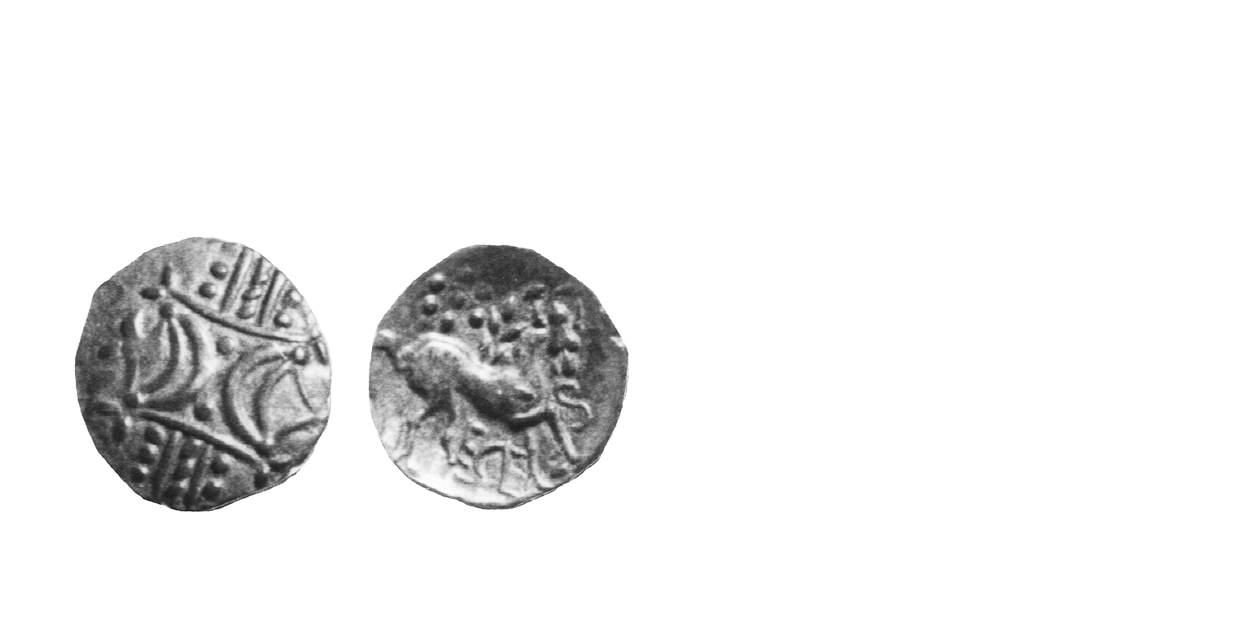
760 - 01 ECEN
35-43 A.D. Common
Silver Unit 1.25 gms. 13 mm
Earliest Record: Stukeley, 1776
OBV: Double crescent emblem
Identifying points:
1) as 730 - 01
REV: Celticized horse right
Identifying points:
1) similar to 730 - 01
2) horse has facing head
3) horse's forelegs extend back through body of horse
4) ECE monogram under horse
CLASSIFICATION: Icenian K
NOTES:
- Many in museums
- The extension of the forelegs through the body of the horse is to reappear on Queen Boudicca's coins – see 790 - 01, 792 - 01 and 794 - 01
- The horse is adapted from an AE Unit of Cunobeline (see 2101 - 01)
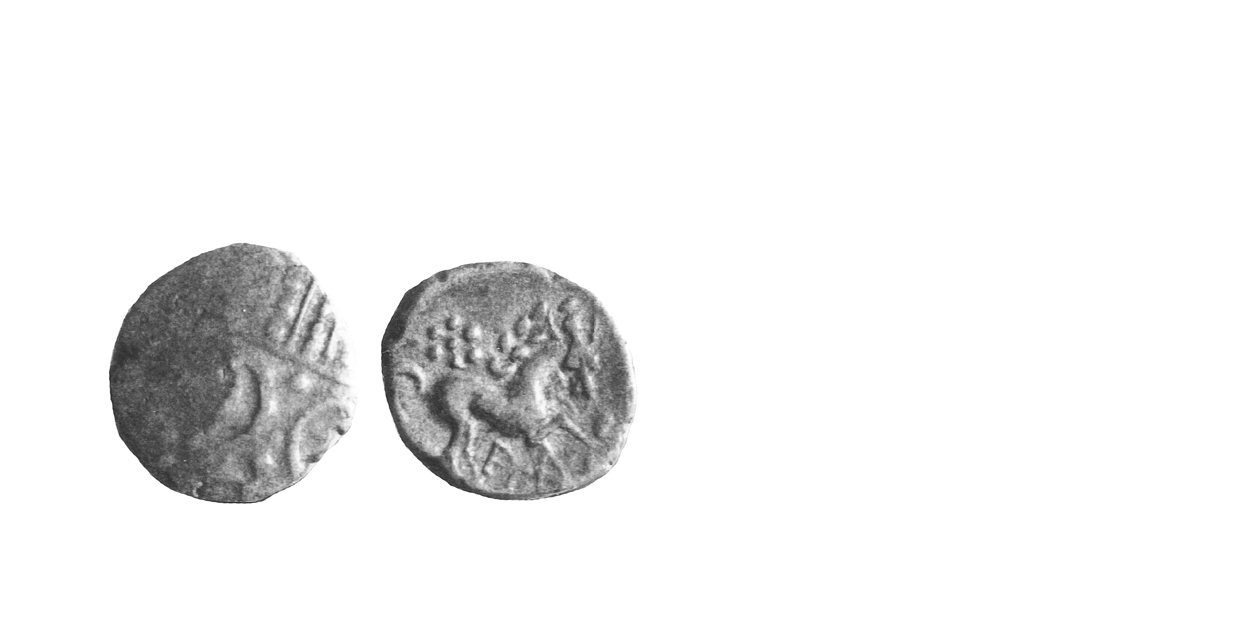
760 - 01 ECEN
35-43 A.D. Common
Silver Unit 1.25 gms. 13 mm
Earliest Record: Stukeley, 1776
OBV: Double crescent emblem
Identifying points:
1) as 730 - 01
REV: Celticized horse right
Identifying points:
1) similar to 730 - 01
2) horse has facing head
3) horse's forelegs extend back through body of horse
4) ECE monogram under horse
CLASSIFICATION: Icenian K
NOTES:
- Many in museums
- The extension of the forelegs through the body of the horse is to reappear on Queen Boudicca's coins – see 790 - 01, 792 - 01 and 794 - 01
- The horse is adapted from an AE Unit of Cunobeline (see 2101 - 01)
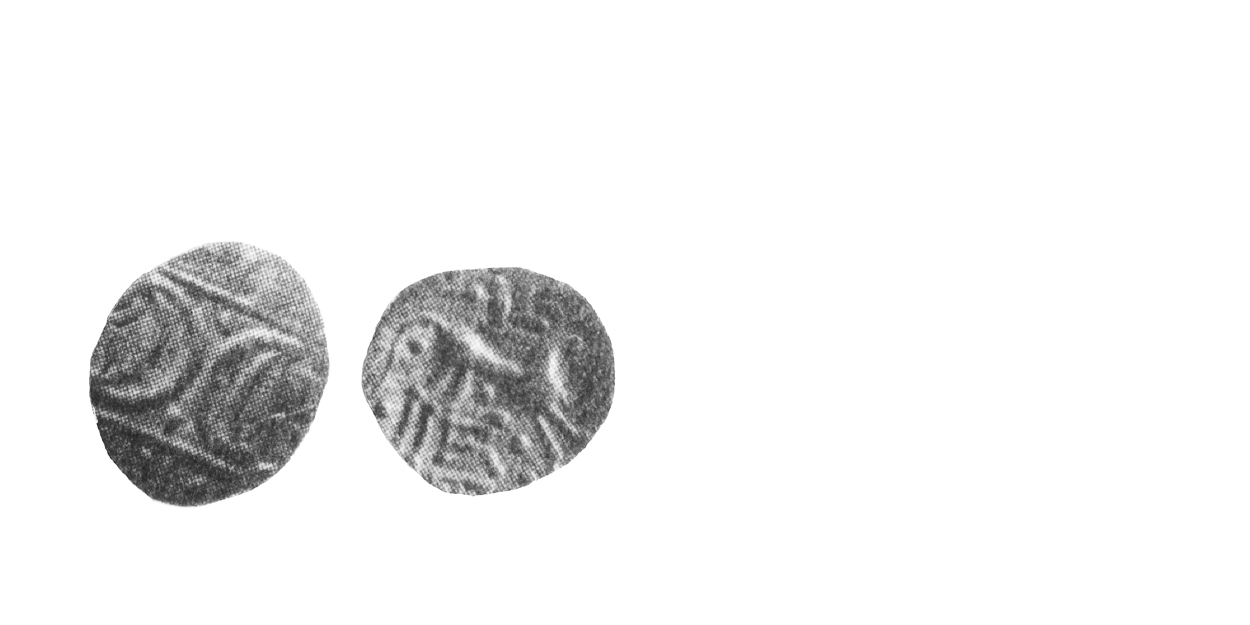
761 - 01 ECEN
35-43 A.D. Extremely Rare
Silver Unit 1.06 gms. 15 mm
Earliest Record: Mack, 1964
OBV: Double crescent emblem
Identifying points:
1) as 730 - 01
REV: Celticized horse left
Identifying points:
1) similar to 730 - 01
2) horse probably has linear head
3) uncertain legend under horse
CLASSIFICATION: Icenian K
NOTES:
- Inaccurate records for this type, probably commoner than indicated
- Legend on reverse not completely certain, Mack read it as 'ECE', oriented vertically, Allen read it as "AHFB?"
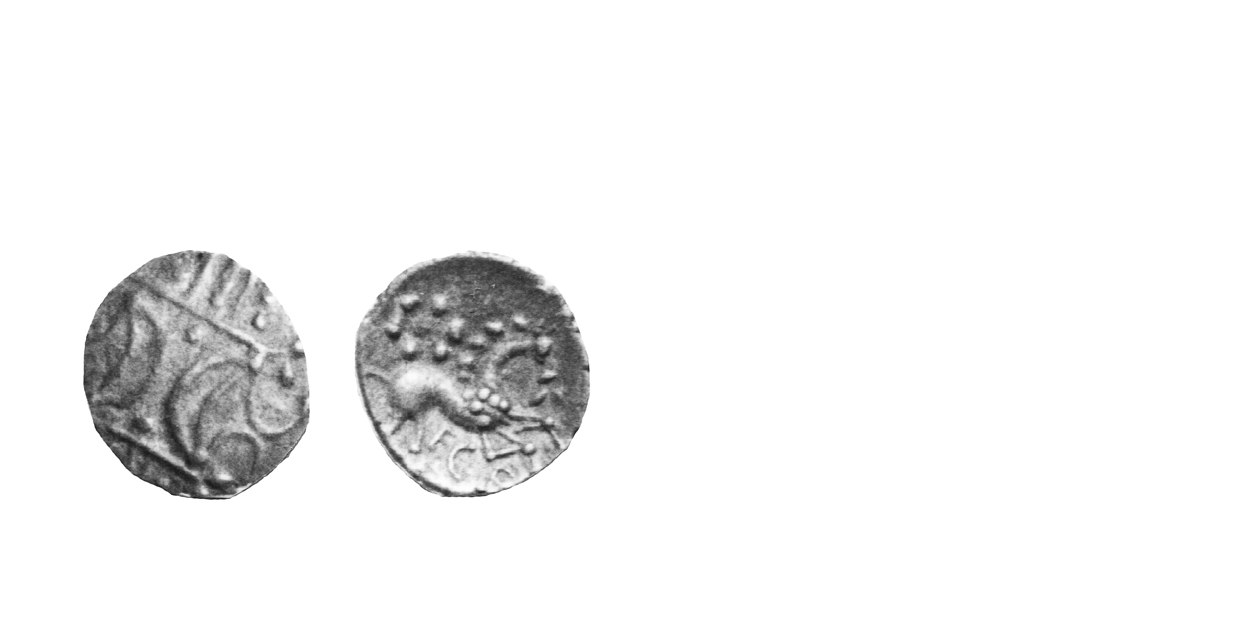
762 - 01 ECEN
35-43 A.D. Common
Silver Unit 1.25 gms. 12 mm
Earliest Record: Poste, 1853
OBV: Double crescent emblem
Identifying points:
1) as 730 - 01
REV: Celticized horse right
Identifying points:
1) similar to 730 - 01
2) horse has linear head
3) six pellets on horse's shoulder
4) ECE monogram under horse
CLASSIFICATION: Icenian K
NOTES:
- Celtic Coin Index records now confirm commoner than originally thought
- Many in museums
- John Talbot assigns this type to Mint Group C
764 - 01 ECEN
35-43 A.D. Scarce
Silver Unit 1.25 gms. 12 mm
Earliest Record: Stukeley, 1776
OBV: Double crescent emblem
Identifying points:
1) as 730 - 01
REV: Celticized horse right
Identifying points:
1) similar to 730 - 01
2) horse has linear head
3) horse's forelegs made up of two lines
4) three pellets on horse's shoulder
5) ECE monogram under horse
CLASSIFICATION: Icenian K
NOTES:
- Celtic Coin Index records now confirm this type commoner than originally thought
- Many in museums
- John Talbot assigns this type to Mint Group C
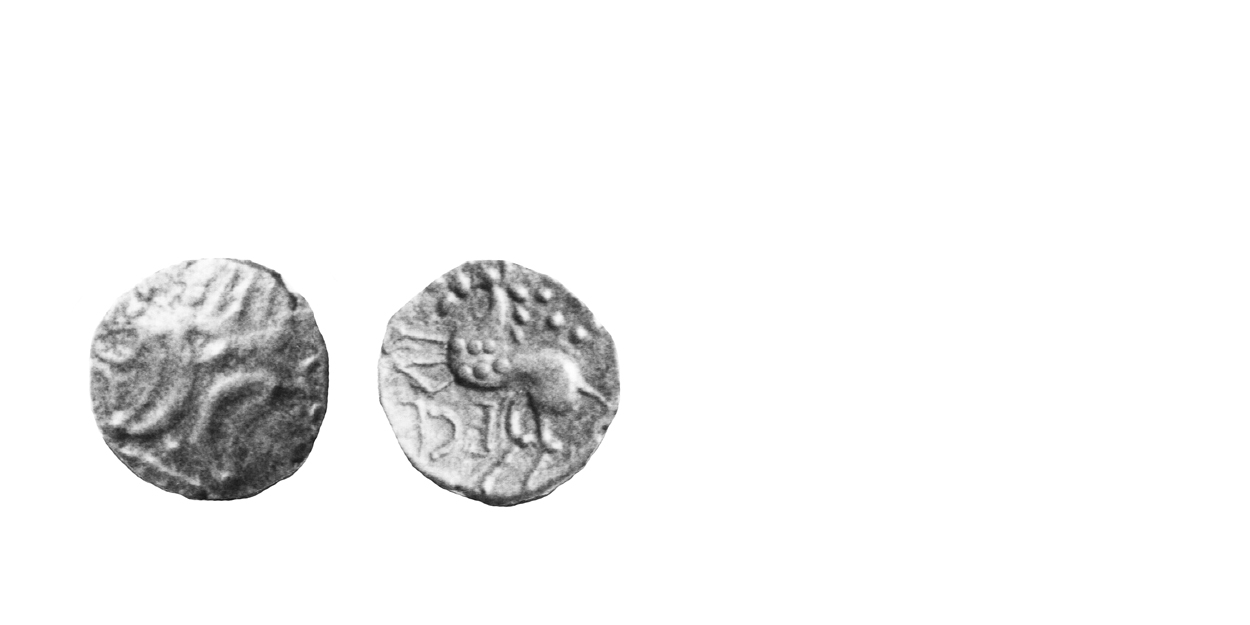
766 - 01 ECEN
35-43 A.D. Scarce
Silver Unit 1.25 gms. 13 mm
Earliest Record:Evans, 1864
OBV: Double crescent emblem
Identifying points:
1) as 730 - 01
REV: Celticized horse left
Identifying points:
1) similar to 730 - 01
2) horse has linear head
3) six pellets on horse's shoulder
4) ECE monogram inverted under horse
CLASSIFICATION: Icenian K
NOTES:
- Celtic Coin Index records continue to support a rarity rating of scarce
- Many in museums
- John Talbot assigns this type to Mint Group C
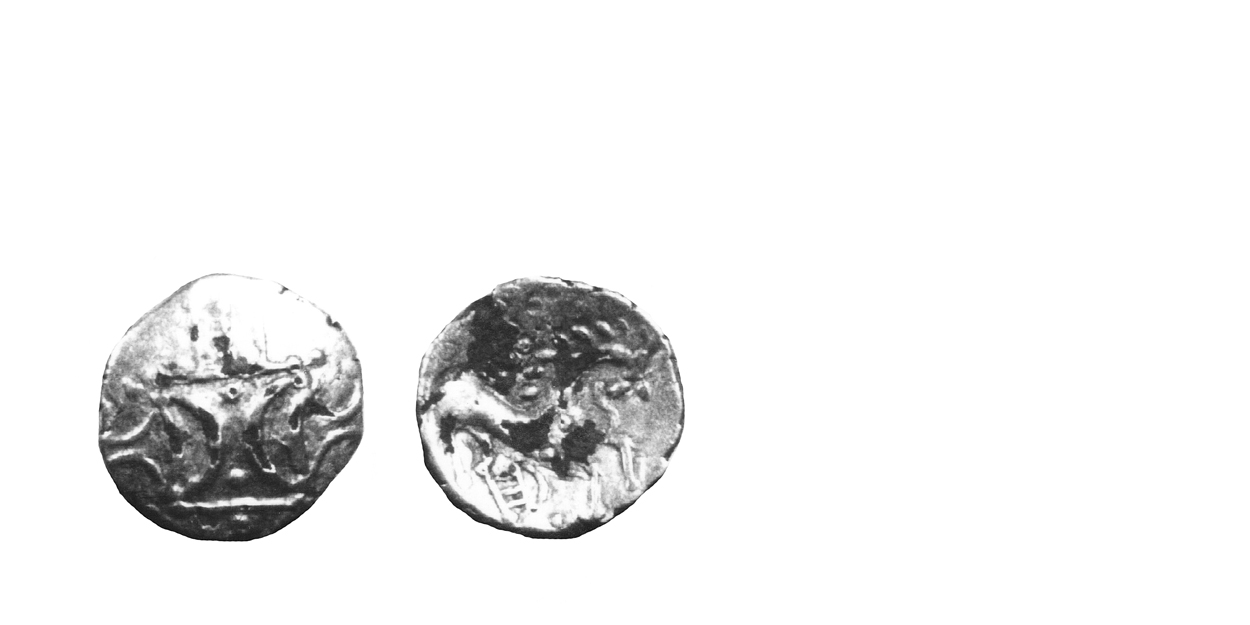
766 - 03 ECEN
35-43 A.D. Extremely Rare
Silver/Bronze Plated Unit 13 mm
Earliest Record: Van Arsdell, 1991 (not published)
OBV: Double crescent emblem
Identifying points:
1) as 730 - 01
REV: Celticized horse left
Identifying points:
1) similar to 730 - 01
2) horse has linear head
3) six pellets on horse's shoulder
4) ECE monogram inverted under horse
CLASSIFICATION: Icenian K
NOTES:
- Ancient forgery of 766 - 01
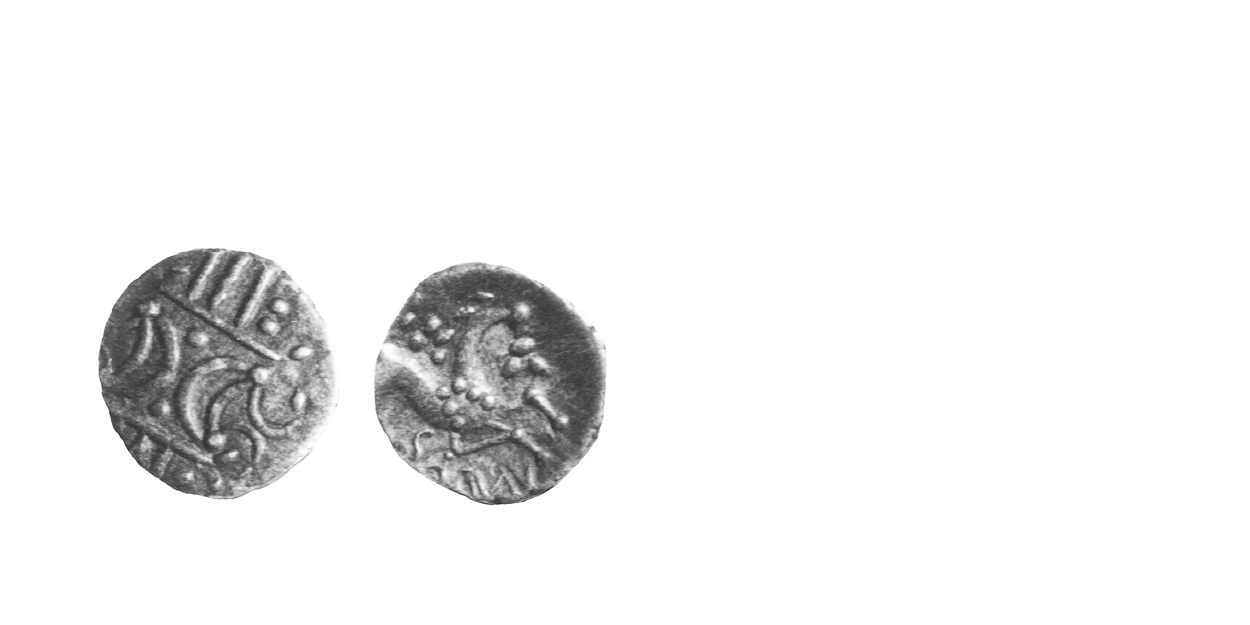
770 - 01 SAENV
35-43 A.D. Scarce
Silver Unit 1.25 gms. 13-14 mm
Earliest Record: Evans, 1864
OBV: Double crescent emblem
Identifying points:
1) as 730 - 01
REV: Celticized horse right
Identifying points:
1) horse has linear head
2) daisy above horse
3) six pellets on horse's shoulder
4) SAENV under horse
CLASSIFICATION: Icenian L
NOTES:
- Many in museums.
- Celtic Coin Index records now confirm type much commoner than originally thought
- Stonea Hoard, 1982, all now in museums, added to tally
- John Talbot assigns this type to Mint Group C
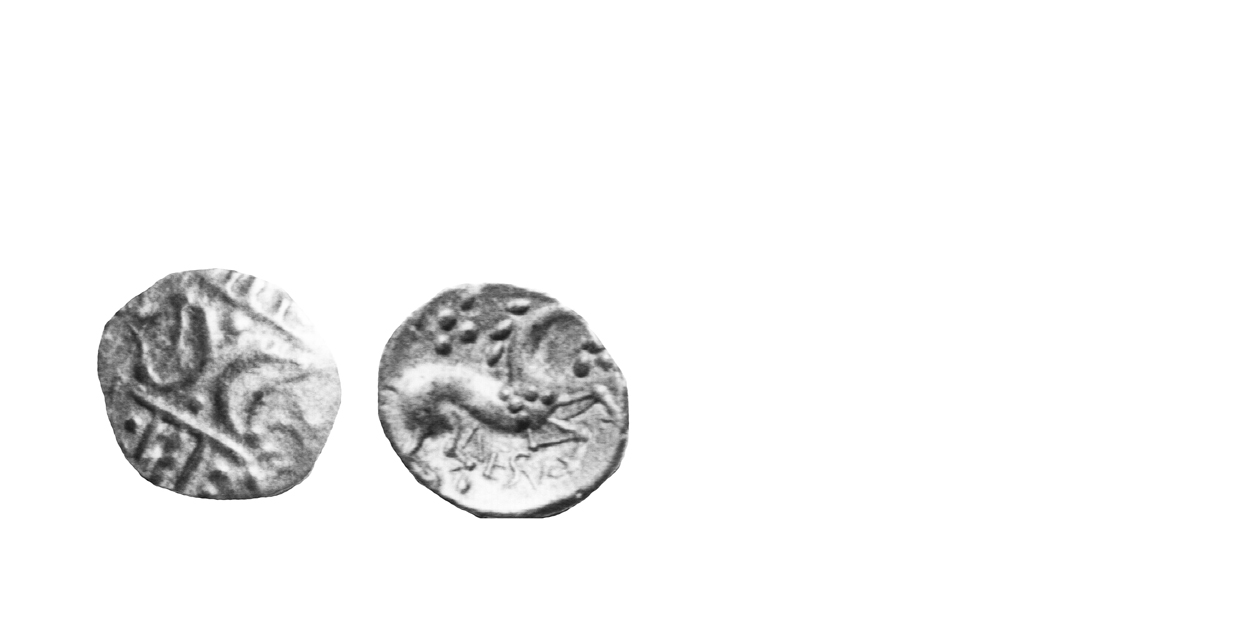
775 - 01 AESV
35-43 A.D. Scarce
Silver Unit 1.25 gms. 12-14 mm
Earliest Record: Evans, 1864
OBV: Double crescent emblem
Identifying points:
1) as 730 - 01
REV: Celticized horse right
Identifying points:
1) as 770 - 01
2) AESV under horse
CLASSIFICATION: Icenian N
NOTES:
- Many in museums
- John Talbot assigns this type to Mint Group C
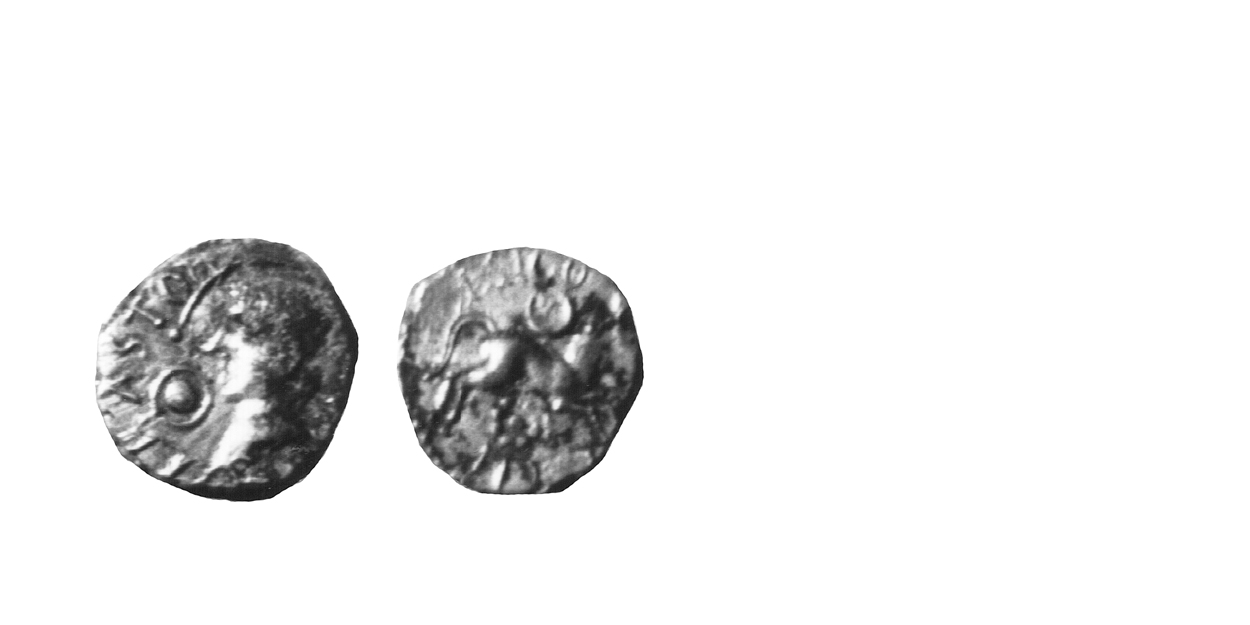
780 - 01 SUB ESVPRASTO ESICO FECIT
35-43 A.D. Extremely Rare
Silver Fraction 0.95 gms. 13 mm
Earliest Record: Mack, 1964
OBV: Romanized head left
Identifying points:
1) ring and pellet motif in front of head
2) SUB ESVPRASTO inscription around head
REV: Celticized horse right
Identifying points:
1) ring and pellet motif above horse
2) ESICO FECIT inscription around horse
NOTES:
- Most extant examples are broken and chipped, possibly explaining the light weight reported
- May actually be a Silver Unit
- John Talbot cautions that this may be a local issue
- Daphne Nash-Briggs suggests SUB ESUPRASTO is a title, not a personal name, and that ESICO is a personal name, not part of a Latin inscription. These suggestions have not gained traction with the research community.
- J. H. C. Williams has provided the best reading of the obverse legend as SVB ESVPRASTO. He suggests that the name "Prasutagus", found only in Tacitus (Annals 14.31), may not be an accurate record of Boudicca's husband's name – that Esuprasto may have been the correct rendering.
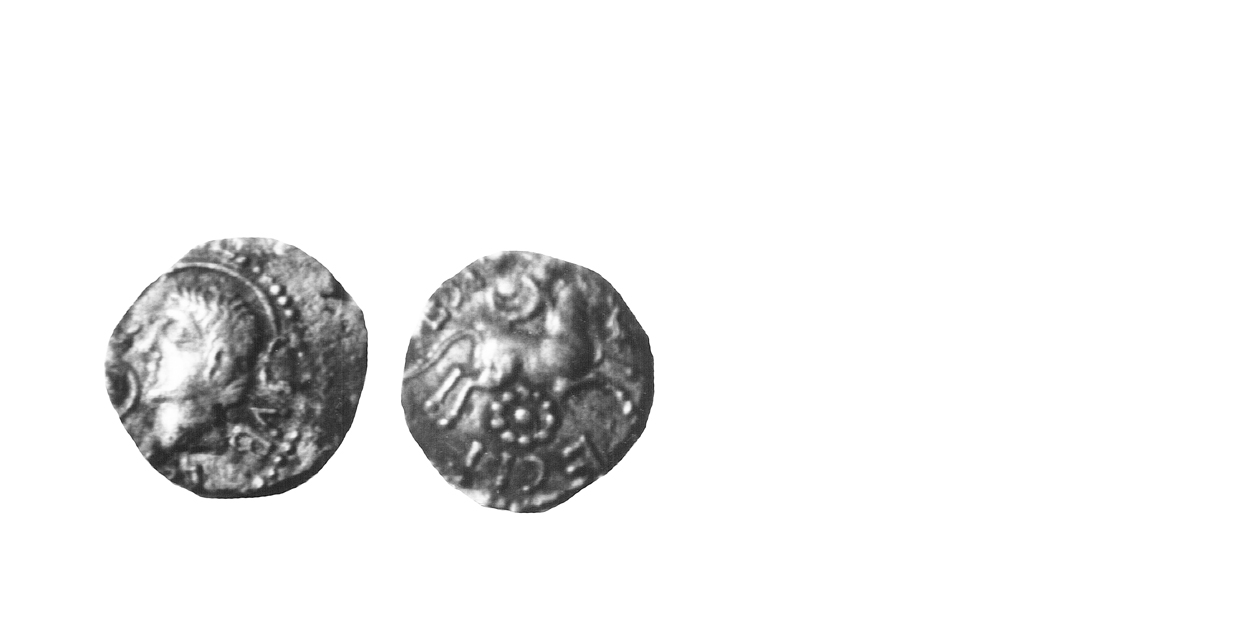
780 - 01 SUB ESVPRASTO ESICO FECIT
35-43 A.D. Extremely Rare
Silver Fraction 0.95 gms. 13 mm
Earliest Record: Mack, 1964
OBV: Romanized head left
Identifying points:
1) ring and pellet motif in front of head
2) SUB ESVPRASTO inscription around head
REV: Celticized horse right
Identifying points:
1) ring and pellet motif above horse
2) ESICO FECIT inscription around horse
NOTES:
- Most extant examples are broken and chipped, possibly explaining the light weight reported
- May actually be a Silver Unit
- John Talbot cautions that this may be a local issue
- Daphne Nash-Briggs suggests SUB ESUPRASTO is a title, not a personal name, and that ESICO is a personal name, not part of a Latin inscription. These suggestions have not gained traction with the research community.
- J. H. C. Williams has provided the best reading of the obverse legend as SVB ESVPRASTO. He suggests that the name "Prasutagus", found only in Tacitus (Annals 14.31), may not be an accurate record of Boudicca's husband's name – that Esuprasto may have been the correct rendering.
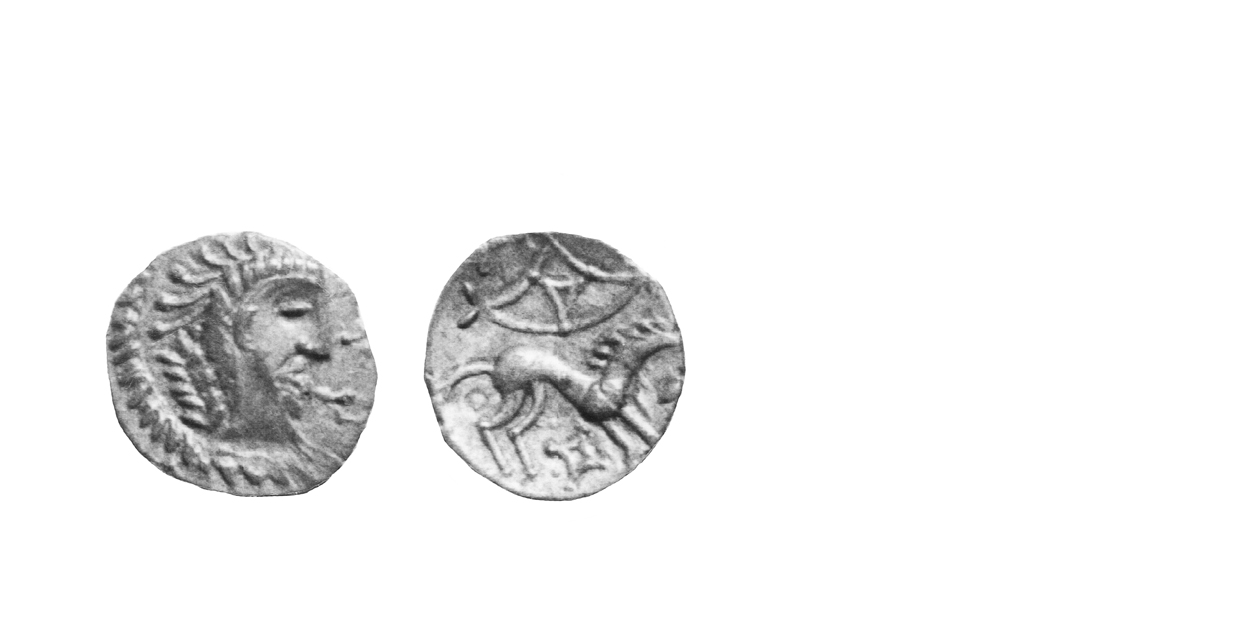
790 - 01 QUEEN BOUDICCA
43-61 A.D. Common
Silver Unit ca. 1.2 gms. 14 mm
Earliest Record: Stukeley, 1776
OBV: Celticized head right
Identifying points:
1) new style head
2) slit for eye
3) vestigial ear
4) hair comprised of straight and curving lines
5) herring-bone pattern behind neck
6) wreath-like object runs behind and below head
REV: Celticized horse right
Identifying points:
1) pellet below horse's tail
2) lozenge-shaped box below horse
3) large, elaborate wheel-like object above horse
CLASSIFICATION: Icenian O
NOTES:
- Many in museums
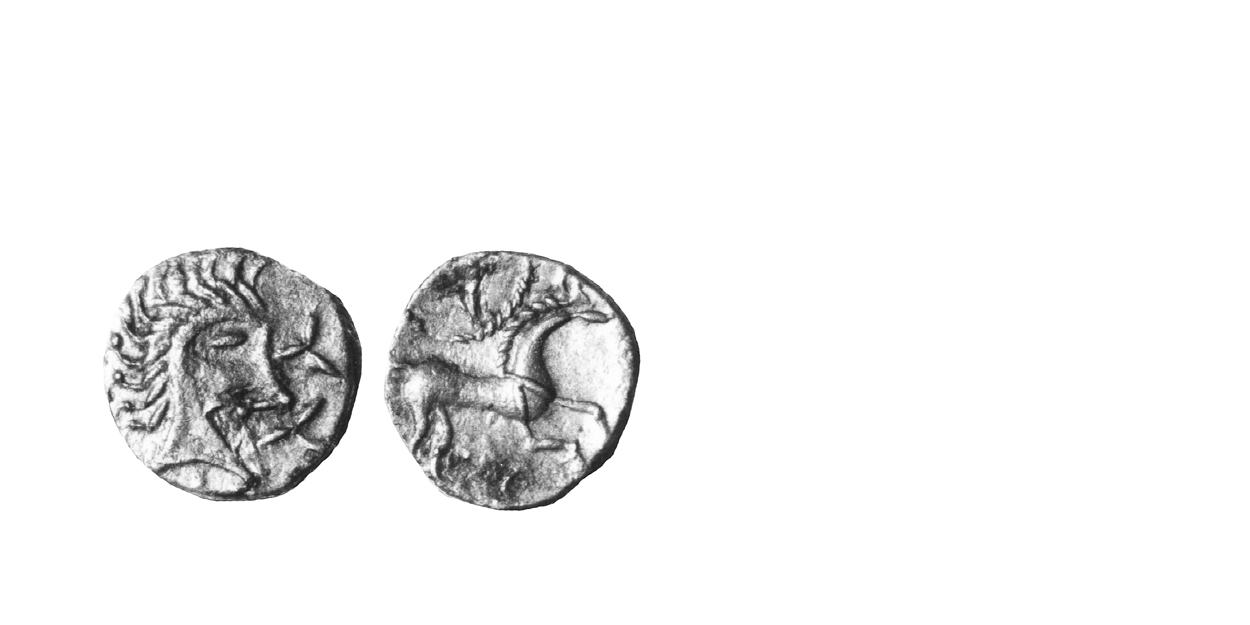
792 - 01 Queen Boudicca
43-61 A.D. Common
Silver Unit ca. 0.9-1.1 gms. 13 mm
Earliest Record: Stukeley, 1776
OBV: Celticized head right
Identifying points:
1) new style head
2) slit for eye
3) no ear
4) hair comprised of straight and curving lines
5) three pellets below head
6) two trefoils in front of face
REV: Celticized horse right
Identifying points:
1) horse has 'necklace' and 'belt' lines, which are continuations of the legs
2) lozenge-shaped box below horse
3) large, elaborate wheel-like object above horse
CLASSIFICATION: Icenian O
NOTES:
- Many in museums
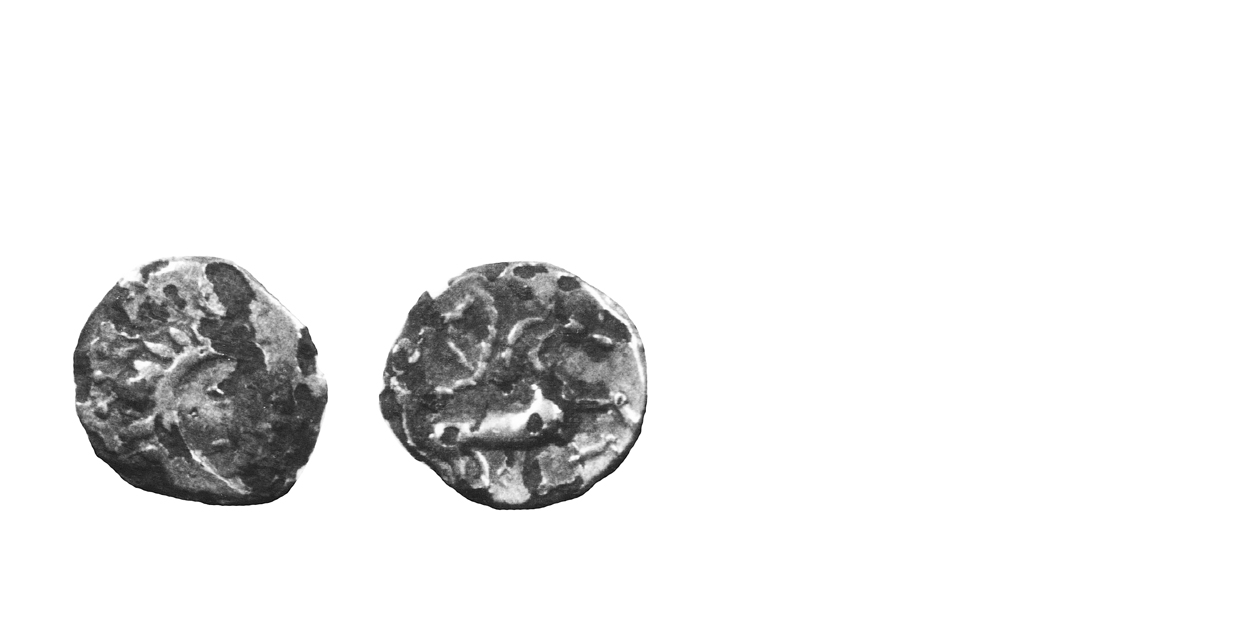
792 - 03 Queen Boudicca
43-61 A.D. Extremely Rare
Silver/Bronze Plated Unit 13 mm
Earliest Record: Van Arsdell, 1991 (not published)
OBV: Celticized head right
Identifying points:
1) new style head
2) slit for eye
3) no ear
4) hair comprised of straight and curving lines 5) three pellets below head
6) two trefoils in front of face
REV: Celticized horse right
Identifying points:
1) horse has 'necklace' and 'belt' lines, which are continuations of the legs
2) lozenge-shaped box below horse
3) large, elaborate wheel-like object above horse
CLASSIFICATION: Icenian O
NOTES:
- Ancient forgery of 792 - 01
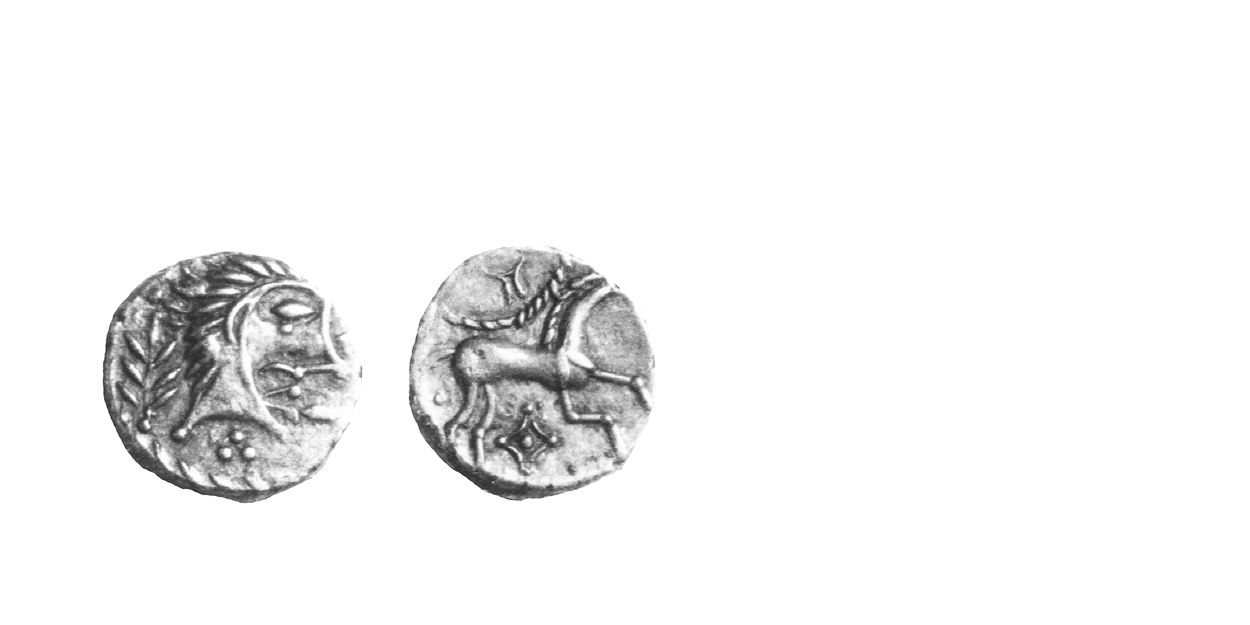
794 - 01 Queen Boudicca
43-61 A.D. Common
Silver Unit ca. 0.9-1.1 gms. 13 mm
Earliest Record: Stukeley, 1776
OBV: Celticized head right
Identifying points:
1) new style head
2) slit for eye
3) no ear
4) hair comprised of straight and curving lines, but curving lines missing behind neck
5) three pellets below head
6) branched emblem, similar to the one on Dobunnic staters, behind neck
REV: Celticized horse right
Identifying points:
1) horse has 'necklace' and 'belt' lines, which are continuations of the legs
2) lozenge-shaped box, with pellet inside, below horse
3) large, elaborate wheel-like object above horse
4) pellet below horse's tail
CLASSIFICATION: Icenian O
NOTES:
- A brockage of this type exists, suggesting the moneyers may have been rushed while striking the coins
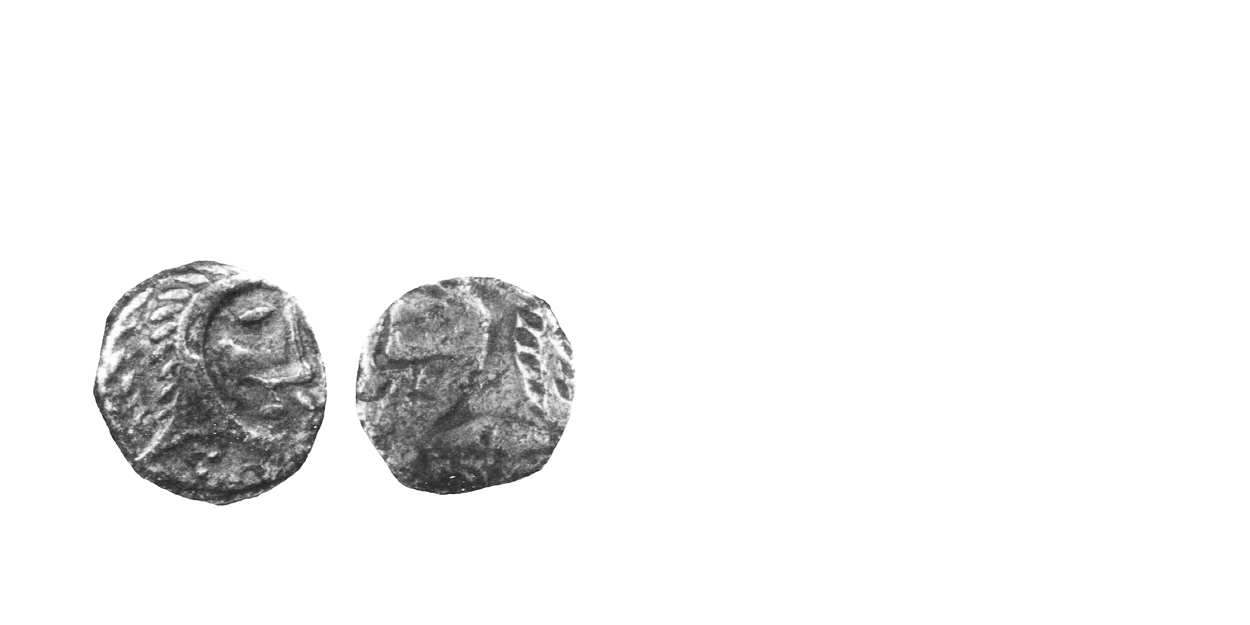
794 - 01 Queen Boudicca
43-61 A.D. Common
Silver Unit ca. 0.9-1.1 gms. 13 mm
Earliest Record: Stukeley, 1776
OBV: Celticized head right
Identifying points:
1) new style head
2) slit for eye
3) no ear
4) hair comprised of straight and curving lines, but curving lines missing behind neck
5) three pellets below head
6) branched emblem, similar to the one on Dobunnic staters, behind neck
REV: Celticized horse right
Identifying points:
1) horse has 'necklace' and 'belt' lines, which are continuations of the legs
2) lozenge-shaped box, with pellet inside, below horse
3) large, elaborate wheel-like object above horse
4) pellet below horse's tail
CLASSIFICATION: Icenian O
NOTES:
- A brockage of this type exists, suggesting the moneyers may have been rushed while striking the coins
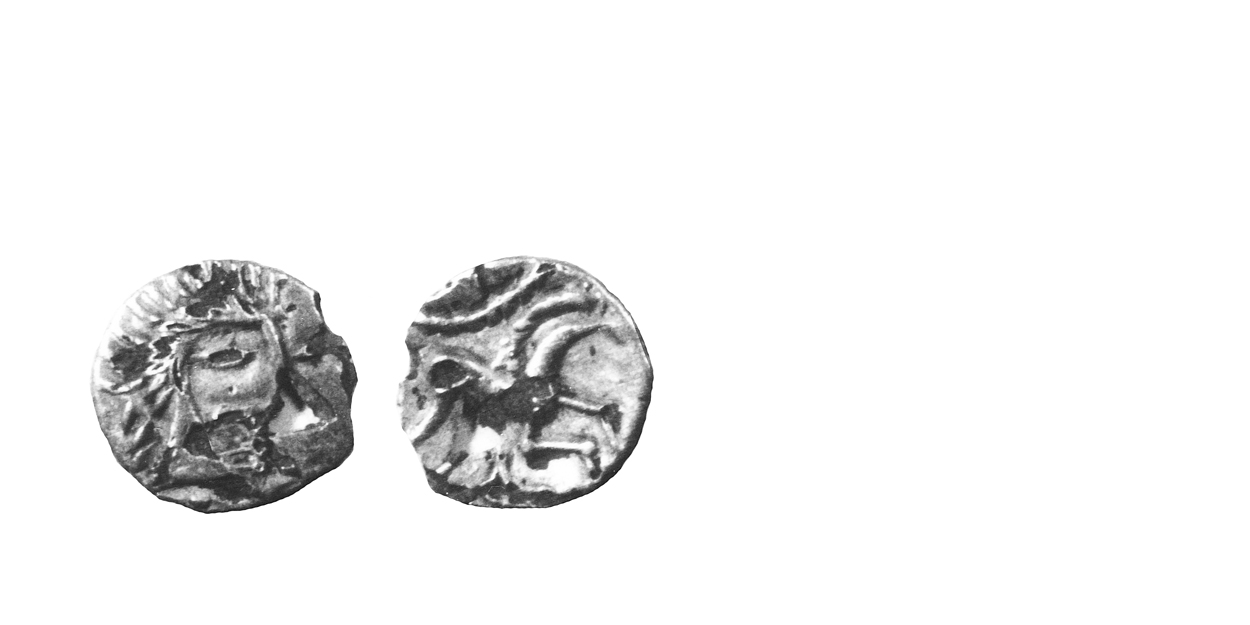
794 - 03 Queen Boudicca
43-61 A.D. Common
Silver/Bronze Plated Unit 13 mm
Earliest Record: Van Arsdell, 1991 (not published)
OBV: Celticized head right
Identifying points:
1) new style head
2) slit for eye
3) no ear
4) hair comprised of straight and curving lines, but curving lines missing behind neck
5) three pellets below head
6) branched emblem, similar to the one on Dobunnic staters, behind neck
REV: Celticized horse right
Identifying points:
1) horse has 'necklace' and 'belt' lines, which are continuations of the legs
2) lozenge-shaped box, with pellet inside, below horse
3) large, elaborate wheel-like object above horse
4) pellet below horse's tail
CLASSIFICATION: Icenian O
NOTES:
- Ancient forgery of 794 - 01
The Coinage of the Iceni
The Iceni occupied the area that is today Norfolk, Suffolk and parts of Cambridgeshire. Until the time of the Gallic War, the tribe seems economically isolated. Large Flan, Defaced Die and Abstract Design Type staters are not commonly found in Icenian territory, and presumably few were imported. Locally-made coins, the NORFOLK WOLF TYPE staters and BURY TYPE silver, were first produced late in the Gallic War. The earliest Icenian gold coinage comprises gold staters with the abstracted head of Apollo on the obverse and a disjointed wolf on the reverse. The heavy weight indicates the series began some time around the end of the war. After the war, the coins become quite debased and bronze cores of plated staters occur with some frequency. Later, a small coinage of SNETTISHAM TYPE coins were struck in gold and silver.
Apparently, extensive trading contacts developed during the war with the Trinovantes/Catuvellauni. A small number of Gallic War Type staters are found and uninscribed staters of the Trinovantes/Catuvellauni also appear. After the war, the coins of Addedomaros and Tasciovanus circulated. It is possible the Iceni relied on these imports instead of striking their own gold in volume.
About 20 B.C., the gold content of the Icenian coinage was restored with the introduction of the FRECKENHAM TYPE. Staters and quarters were struck lighter in weight to conform with the coinages of the other British tribes. The staters had a flower pattern or cross of pellets on the obverse and a Celticized horse on the reverse. Three major types occurred, described either as EARLIER and LATER, based on style and the progressive damage to one particular die linked with several others. Since all three types occurred in the Freckenham Hoard, it is likely they were contemporary.
After the war an extensive Icenian silver coinage was produced, which probably continued up to the time of the Boudiccan Rebellion. Silver units were produced to a standard weight of 1.25g. for nearly 100 years, a remarkable economic and technological achievement. There was a bewildering succession of types, subtypes and minor die varieties. These varieties have been systematically analyzed by John Talbot, and the arrangement is now reasonably certain. It appears that in any given period, three separate kinds of silver were being struck. Talbot suggests that the main Icenian mint either had two branch mints, or alternatively three workshops within a single mint. It is also possible that the different kinds of silver were either produced for different purposes, or perhaps at different times within a given period. Generally, the absolute chronology needs additional work. The chronology used here makes use of the work reported in John Talbot and Ian Leins's 2010 paper in The British Numismatic Journal.
The FRECKENHAM TYPE disappeared by 20 A.D. and the uninscribed silver coins were superseded by the dynastic. Very few inscribed gold coins are known. It is possible the gold coinage was minimal and the Iceni used silver coins augmented with Trinovantian/Catuvellaunian gold after 20 A.D. The Icenian dynastic period is largely one of a prolific silver coinage, beginning with the addition of an inscriptions to the CRESCENT TYPE and the introduction of the EMBLEM TYPE.
Most of the major types are listed here, but some of the minor issues need to be added. The dating of the various issues is controversial and that offered is somewhat arbitrary, based on die studies, typological sequences and analyses of coin hoards deposited around the rebellion of 61 A.D.
